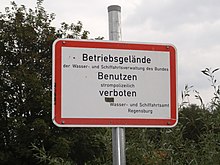Company premises
A premises is mostly in private property standing, non-public area, on the equipment , premises , administrative and head offices of companies are located.
General
A legal definition of the company premises as a "demarcated part of the earth's surface on which there are facilities, business facilities or operational areas that are spatially, technically or operationally related and subject to the supervision or control of a natural or legal person (operator)" can be found in § 82 para. 2 number 2 LWasserG (BW). It is in the area that is used for commercial use by companies and can range from small businesses to large industrial parks . The importance of the site lies primarily economically is essential part of the business assets to be while pursuant to ambient pollution , a source of danger for the workers and the general public may present. Since it is privately owned, the road traffic regulations do not have to apply here; the operator has house rights .
Regulations
In Germany there are no general rules for fencing in company premises. The EC directive 89/654 / EEC contains some regulations regarding traffic routes and danger areas on company premises. Accordingly, unauthorized workers must be prevented from entering areas on company premises where there is a risk of objects falling. Furthermore, there is an obligation to fence in according to the general traffic safety obligation for parts of the system that can pose a particular risk to life and limb, such as those with openly live parts, risk of falling or the like ( Section 5 (1) (1) BImSchG ).
Insurance situation
For the insurance- related processing of work or service accidents , it is decisive whether they occurred on the company premises or outside of it (cf. § 8 SGB VII ).
Web links
- Literature on company premises in the catalog of the German National Library
Individual evidence
- ↑ Directive 89/654 / EEC of the Council on minimum requirements for safety and health protection in workplaces (see Appendix 1, points 12-14)
- ↑ Klaus Golka / Jan Hengstler / Stephan Letzel / Dennis Nowak, traffic medicine - occupational health aspects , Verlagsgruppe Hüthig Jehle Rehm GmbH, 2011, p 34; ISBN 978-3-609-10576-5 .
- ^ Martin Kock, industrial accidents of entrepreneurs: liability and insurance , Verlag Versicherungswirtschaft, Karlsruhe 2002, p. 140; ISBN 3-89952-010-6

